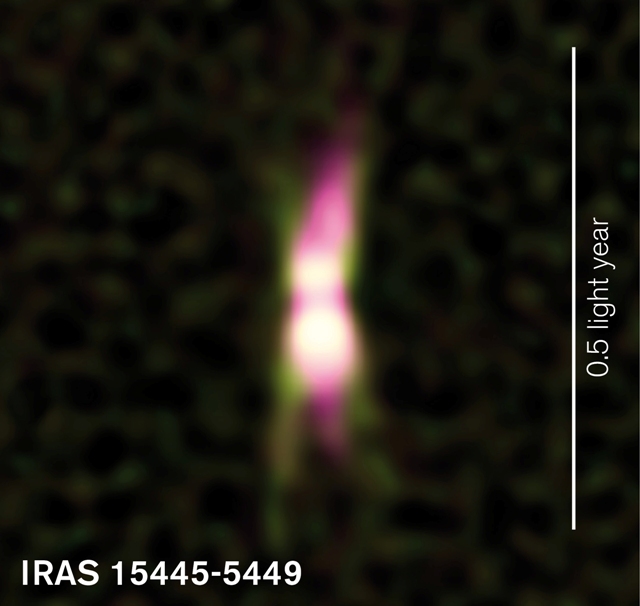Sep 17 2013
An old star, IRAS 15445-5449, has begun to push out a jet of charged particles that glow with radio waves.
 CSIRO Australia Telescope Compact Array observations of a jet of energetic particles emitting radio waves (shown in pink), coming from the star IRAS 15445-5449. Dusty material around the star (shown in green) was imaged with ESO's Very Large Telescope Interferometer. The star itself is hidden by dust. (Credits: A. Pérez-Sánchez /ATCA/CSIRO; E. Lagadec/ESO)
CSIRO Australia Telescope Compact Array observations of a jet of energetic particles emitting radio waves (shown in pink), coming from the star IRAS 15445-5449. Dusty material around the star (shown in green) was imaged with ESO's Very Large Telescope Interferometer. The star itself is hidden by dust. (Credits: A. Pérez-Sánchez /ATCA/CSIRO; E. Lagadec/ESO)
A few old stars are known to have jets, "but this is the first one where the radio waves tell us the jet is held together by a strong magnetic field", said Dr Jessica Chapman of CSIRO Astronomy and Space Science, a member of the research team.
"That's a clue to what makes these jets switch on."
The finding has been published online today [Monday 16 September] in the journal Monthly Notices of the Royal Astronomical Society.
IRAS 15445−5449 lies 23 000 light-years away in the southern constellation Triangulum Australe (the Southern Triangle).
The radio waves from the star's jets were detected with CSIRO's Australia Telescope Compact Array, an array of six 22-m diameter radio dishes near Narrabri in New South Wales (eastern Australia).
The flowering star is turning into one of the most beautiful objects in space — a "planetary nebula".
Planetary nebulae are large glowing objects that early astronomers thought looked like planets. In fact they are stars late in their lives that have shed much of their gas into space. The shed gas glows, powered by energy from the old star's tiny core.
Like Spring flowers, planetary nebulae blossom and go. The "jet" phase seems to show the first stages of the star becoming a planetary nebula. This phase is just a "blink of an eye in a star's life," says Dr Chapman, "probably lasting only about a hundred years".
Roughly half the known planetary nebulae are round blobs. The other half are long and symmetrical, often like a Christmas cracker.
"The question is, what makes this symmetry?" Dr Chapman said.
It could be that the outflowing gas is shaped by the presence of a companion to the old star — another star, or a planet.
A second idea, which Dr Chapman favours, is that it's the magnetic field of the old star.
"The magnetic field may get twisted up as the star shrinks, perhaps launching these jets," she said. But more detailed observations are needed to clarify how jets form.